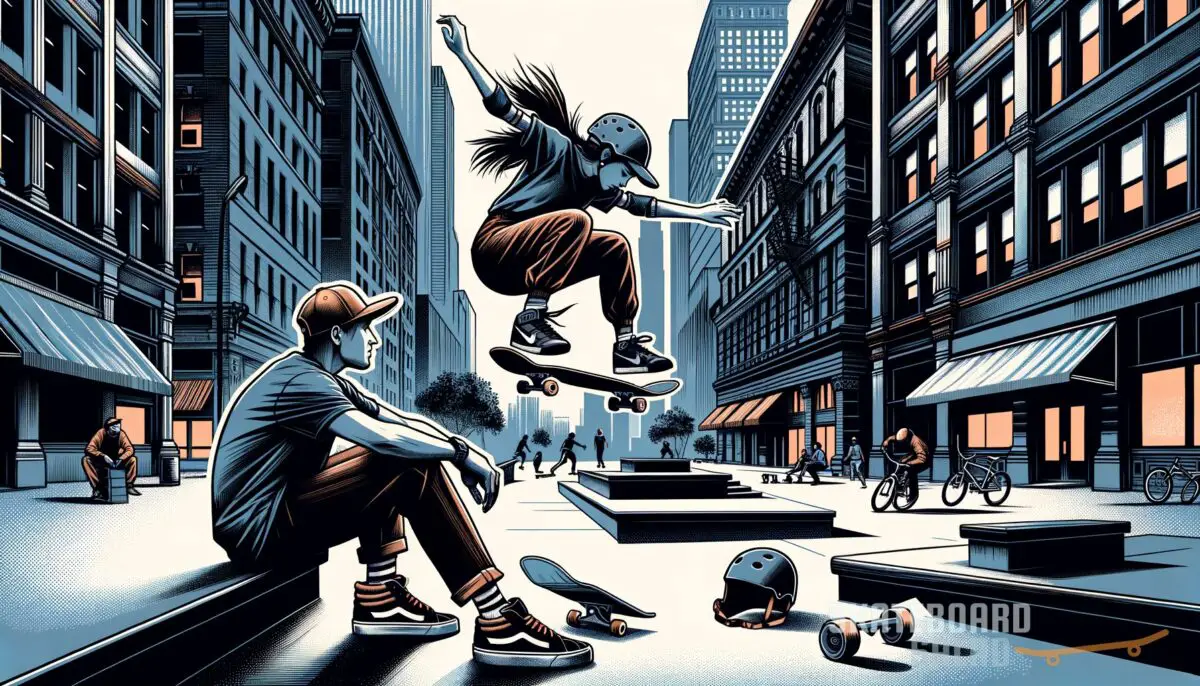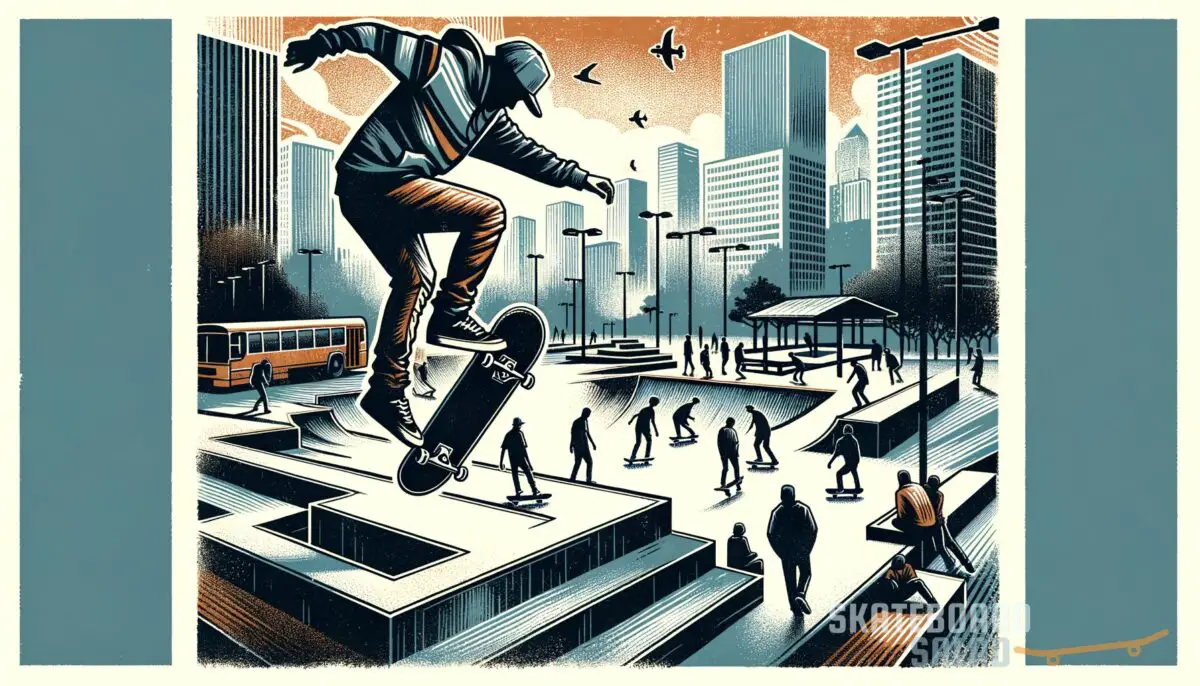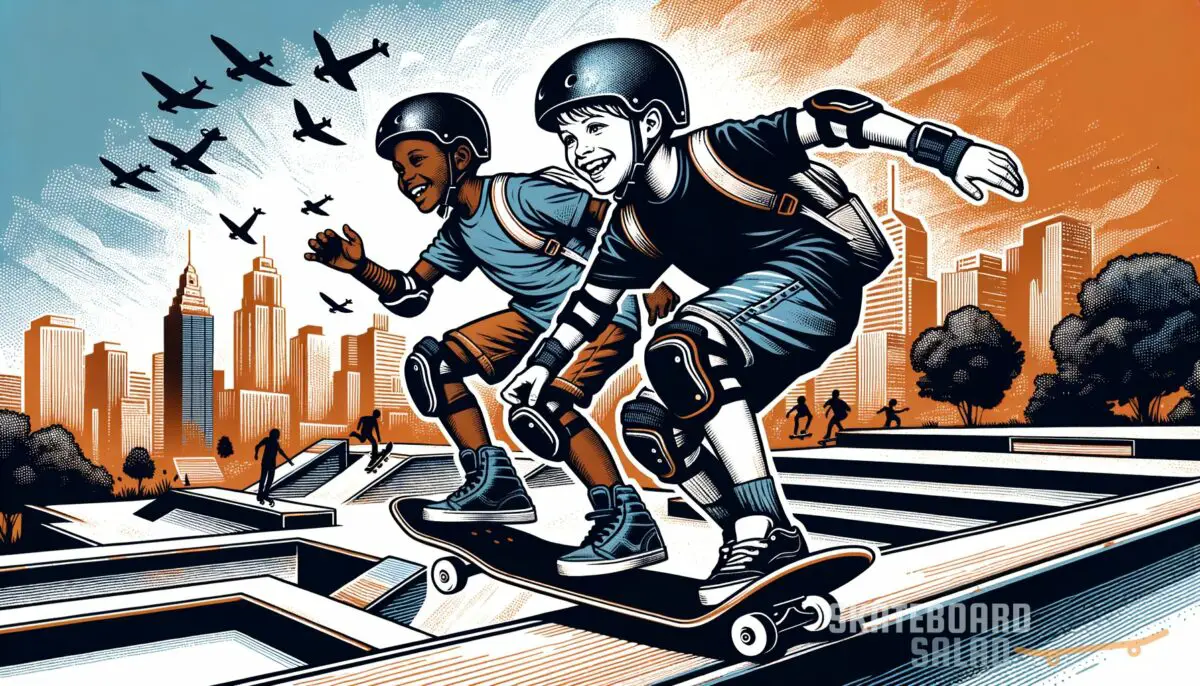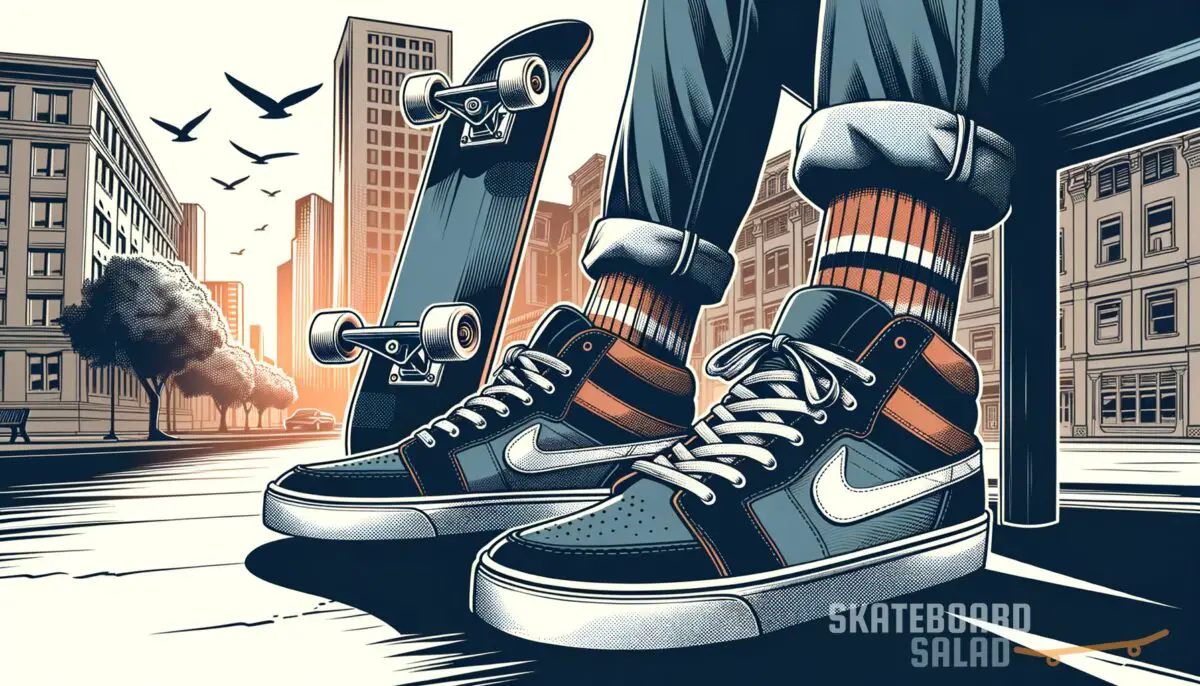Are you ready to shred some gnar, my friends? Because today, we’re diving headfirst into skateboarding history. That’s right, we’re talking about the pastime that’s taken the world by storm and left its mark on everything from fashion to film.
In this post, we’ll explore everything from its early beginnings to the current state of the sport. We’ll uncover the pioneers who first took to the streets with their makeshift boards and see how the sport has evolved over the years into the adrenaline-fueled, gravity-defying spectacle we know and love today.
Plus, we’ll explore the culture and community that’s grown up around skateboarding. So, are you ready to start? Grab your deck, and let’s get rolling, folks!
What is skateboarding?
Skateboarding is a recreational activity and sport in which a person rides standing balanced on a small board mounted on wheels. The skateboard has three major parts – the deck, trucks, and wheels. Considered an extreme sport, skateboarding as a professional sport boasts a range of competitions, including vertical and street-style events.
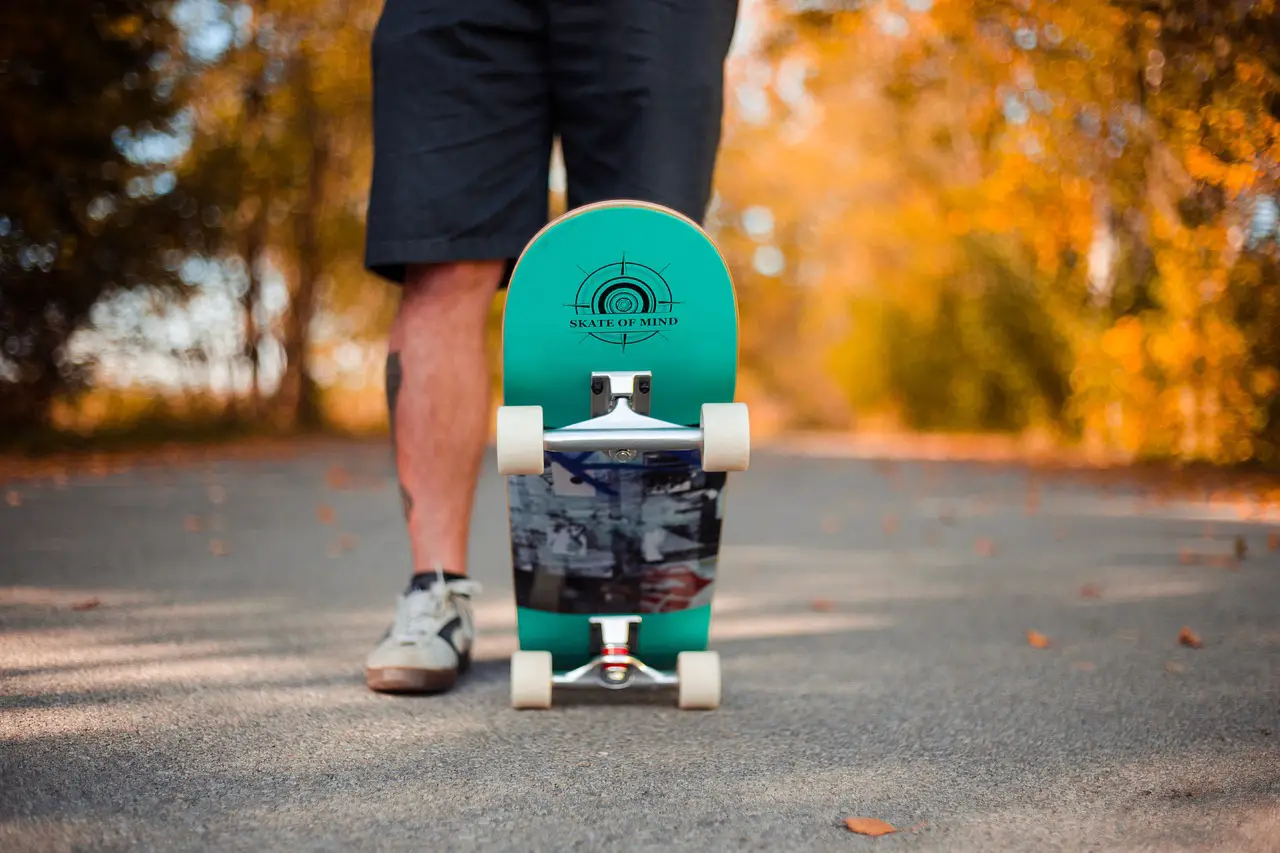
Skateboarding is also a cultural movement that has come to define urban cool. It is a popular activity among young people, with riders performing tricks on a skateboard. The sport has seen significant growth and development since its inception in 1960s California, with new tricks and technologies pushing the limits of what is possible.
Skateboarding has become so popular that it is now an Olympic sport. With a strong sense of community and a focus on creativity and individual expression, skateboarding remains a beloved and enduring sport.
Enjoi Whitey Panda Complete Skateboard

Enjoi Whitey Panda Complete Skateboard
Why is it important to learn about the history of skateboarding?
Learning about the history of skateboarding is important because it highlights the sport’s significance and cultural impact. Skateboarding has inaugurated its museums, was awarded its hall of fame and curated a self-documented history cementing a special place in the heart of freedom culture.
Skateboarding has developed as a youth subculture emphasizing creativity and individuality, offering an alternative to mainstream team sports that are more formally organized and largely controlled by adults. Additionally, the skateboard has given rise to a vibrant art, music, and sports culture, with many artists, musicians, and athletes finding inspiration in skateboarding culture.
Furthermore, learning about the history of skateboarding provides insight into the evolution of the sport, including the key innovations and trends that have shaped it over the years. It also offers a better understanding of the skateboarders who pioneered the sport and the culture that has grown up around it. By learning about skateboarding history, one can appreciate the sport’s significance while gaining a deeper appreciation for this sport.
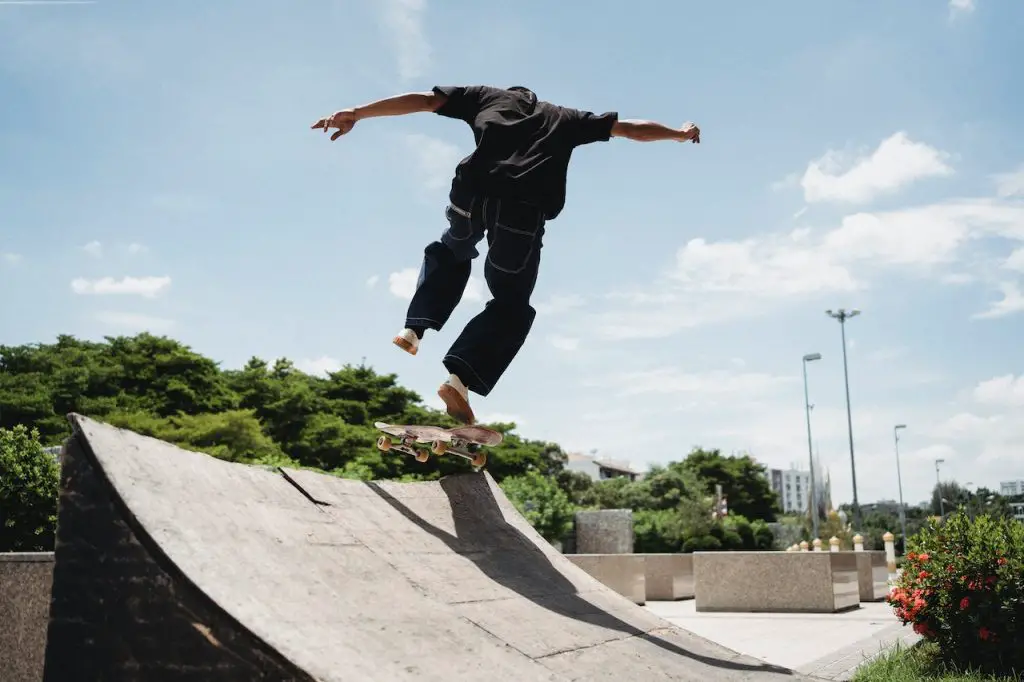
The history of skateboarding
From its humble origins as a pastime for surfers in California to becoming a beloved and enduring activity for millions of people worldwide, the history of skateboarding is a fascinating and inspiring story. Let’s take a deep dive into the evolution of skateboarding.
1950s
Surfing can be traced back to the early 1950s as the origin of skateboarding. Some surfers had the great idea to take the feeling of riding waves onto the streets to stop time when there was only a small swell. These guys were dubbed “asphalt surfers” for a reason.
During this time, a type of skateboard was developed in California and Hawaii. They used shorter surfboards and metal wheels that lacked bearings.
Skateboarding had its peak in the late 1950s. The United States economy flourished after WWII, which impacted the toy business. They became aware of the board with wheels. Roller Derby released the first official skateboard with significant technological advances in 1959. As a result, the handling characteristics have improved, and skateboarders were able to create new tricks and routines.
1960s
Skateboarding became more popular in the United States between 1959 and 1965. In 1962, a surf shop in Hollywood called Val-Surf sold the first self-made skateboards. These boards were sold as “complete.” They looked like regular surfboards but had roller skate trucks on the bottom. The same year, Patterson Forbes made the first full boards with trucks in a factory.
Skateboarders showed off their skills in different events, like slalom and freestyle, and sponsors started putting together teams to pay the riders.
In 1963, the editor of “Surf Guide Magazine,” Larry Stevenson, put the first ad for a skateboard. The clothing business has also been increasingly focused on skateboarding. Vans, one of the most well-known skateboarding shoe brands today, was founded in 1966.
The same year, the inaugural skate contest was held in Hermosa Beach, California. Skateboarding was no longer simply for cruising. Skateboarders showed off their skills in different events, like slalom and freestyle, and sponsors started putting together teams to pay the riders.
In 1964, as skating’s popularity grew, the first skateboarding magazine, “The Quarterly Skateboarder,” was published. The next major step was to refine the shape of the boards. Finally, Larry Stevenson designed the “kicktail,” which opened up new ways to ride a skateboard.
1970s
Change is the only constant, and thus it came to a point where everything changed for skateboarding. Frank Nasworthy’s creation of urethane wheels in 1972 became a game-changer. Nasworthy made Cadillac Wheels of a new material that made rides faster, smoother, and more comfortable.
Several disciplines, including freestyle, downhill, and slalom, reached new heights. The year 1975 saw the release of many magazines, like “Skateboarder Magazine,” and the start of new events. The first artificial skate park opened in 1976, and new features like vertical ramps and kickers were added to parks after that.
In the mid-1970s, skateboarding reached Germany. The American soldiers brought the sport with them, and by 1976, Munich became the first German skateboard center where the first skate park was built, and the first German skateboard championships were held in 1978.
Then in 1978, Alan Gelfand invented a maneuver that gave skateboarding another revolutionary jump: the “ollie,” which counts as the greatest trick ever invented and completely revolutionized skateboarding. That was the birth of street skateboarding!
1980s
Rodney Mullen was one of the first skateboarders to use the ollie on the streets, promoting a new style of skating. Street skateboarding grew in popularity with other enjoyable sports like BMX and inline skating.
The “Thrasher Magazine” was launched in 1981 and has featured street skating, the core scene, punk rock, and the lifestyle slogan “Skate And Destroy” ever since. Another well-known publication, “Transworld Skateboarding Magazine,” came out in 1983. With these periodicals, a few smaller ones sprouted up, and more skate stores opened.
As a result, the popularity of skateboarding has grown. In addition, the global adoption of brand-new tricks and unheard-of skate moves made the first skate videos on VHS possible. Many people saw the importance of videography in the scene.
…skateboarding has become much more popular, and pro skateboarders are now as well-known as baseball or football players.
Skateboarding also became increasingly popular in Germany. Titus Dittmann was a driving force behind the growth of skateboarding in Germany. He brought skateboarding gear from the U.S. and held skateboarding tournaments and other events. In the 1980s, the “Münster Monster Mastership” became one of the most important worldwide skating championships.
From the mid-1980s on, it was possible to make a solid living as a professional skateboarder with the development of the skateboard industry in the United States. Powell Peralta, Santa Cruz, and Vision were brands that dominated the international market in the late 1980s. In addition, shoes became a major influence on fashion. Vans, Converse, and Vision shoes were synonymous with the skateboarding scene.
With several competitions and events held every year, skateboarding has become much more popular, and pro skateboarders are now as well-known as baseball or football players. Vert skateboarding has also given way to street skateboarding.
1990s
Due to the development of many trendy sports in the early 1990s, skateboarding went through a more in-depth phase. The sport has maintained its public presence due to digital technology. Modern skateboarding peaked in the mid-1990s and continues to this day.
The “X-Games” and other mega-events were launched and televised. Skateboarding became popular worldwide because of magazines, events, videos, and the internet.
Brands like Chocolate, Girl Skateboards, and Flip Skateboards improved skateboarding hardware, and skateboarders could buy high-quality boards in any major city.
The skateboarding scene continued its rise with the large and well-known “Street League” tournaments. The “Street League Skateboarding” competition series is for worldwide pro skaters. Only the top street skateboarders, such as Nyjah Huston, Eric Koston, Paul Rodriguez, Andrew Reynolds, Ryan Sheckler, and Torey Pudwill, are featured here.
In Germany, as in the United States, street skating is the most popular type of competition. But the skate culture in Europe and Germany is its own thing, with its own pro and national competition series.
Skateboarding in the 2000s up to the present
Skateboarding has gone through several changes and trends from the 2000s up to the present day. Street-style skateboarding became increasingly popular. Skaters began performing tricks in urban environments, using stairs, rails, and ledges as their obstacles. This style of skateboarding was showcased in popular skate videos such as Girl Skateboards’ “Yeah Right!” and “Fully Flared,” as well as in Tony Hawk’s Pro Skater video game series.
Skateboarding culture continued to grow in popularity throughout the 2000s and 2010s. Skateboarders became more prominent in mainstream media, and skateboarding-inspired fashion and music became more prevalent.
Skateboarding organizations and brands have made efforts to promote gender and racial diversity, as well as to make the sport more accessible to people with disabilities.
The growth of skateboarding as a sport was evident when it became an Olympic sport. Skateboarding made its official debut in the 2020 Summer Olympics in Tokyo. This recognition has led to more funding and support for skateboarding events and competitions, as well as increased exposure for professional skateboarders.
Social media has become a key tool for skateboarders to showcase their skills and connect with fans. Platforms such as Instagram, YouTube, and TikTok have allowed skateboarders to share their tricks and stunts with a global audience. They have also led to the growth of influencer culture within the skateboarding community.
In recent years, there has been a greater focus on diversity and inclusion within skateboarding. Skateboarding organizations and brands have made efforts to promote gender and racial diversity, as well as to make the sport more accessible to people with disabilities.
Overall, skateboarding has continued to evolve and adapt to changing trends and cultural shifts from the 2000s up to the present day. Despite its mainstream popularity, skateboarding remains rooted in its counterculture origins and continues to be a beloved pastime and sport for millions of people around the world.
If you want even more tips and insights, watch this video called “A Brief History Of Skateboarding” from the Shredz Shop YouTube channel.
Conclusion
Well, folks, it looks like we’ve reached the end of our journey through the wild and wonderful history of skateboarding. I hope you’ve enjoyed learning about the early pioneers, the iconic moments, and the culture that’s grown up around this incredible sport.
Did I cover everything I wanted to know? If you’ve got a question or comment or just want to share your own experiences with skateboarding, drop a line in the comments section below. I read and reply to every comment. And don’t forget to share this post with your friends – who knows, maybe you’ll inspire someone to pick up a board and start shredding!
Thanks for joining me on this journey, and until next time, keep rolling and have fun!
Key takeaways
This article covered skateboarding history. Here are some key takeaways:
- Skateboarding has a rich and fascinating history that dates back to the 1950s.
- The early pioneers of skateboarding created their boards by attaching wheels to pieces of wood, and the sport quickly grew in popularity.
- The 1970s saw the emergence of skate parks, and the sport continued to evolve with the introduction of new tricks and styles.
- The 1980s and 1990s brought further innovations in skateboarding, with new tricks and technologies pushing the limits of what was possible.
- The 2000s saw the popularity of street skateboarding, its presence in mainstream media, and its push for inclusion and diversity.
- Skateboarding culture has significantly impacted fashion, music, and art, and the sport has influenced many aspects of modern society.



